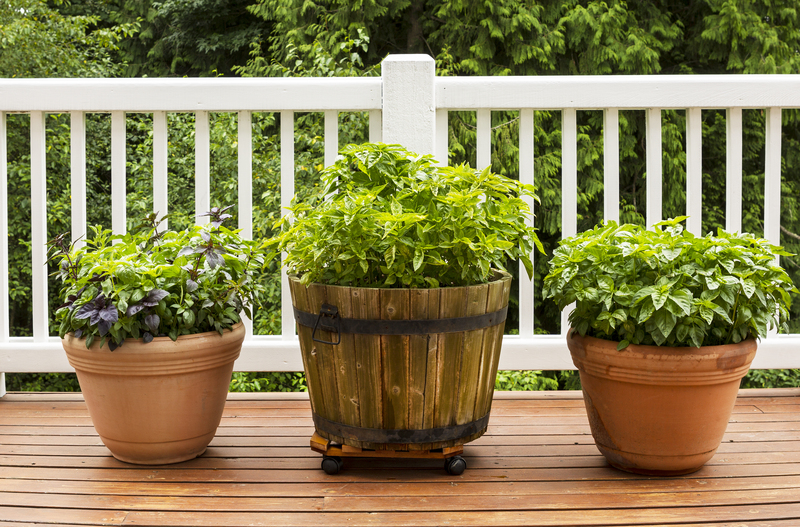Building a Robust Garden: Strategies for Severe Weather Defense
Posted on 14/08/2025
Building a Robust Garden: Strategies for Severe Weather Defense
A robust garden offers more than just beauty; it stands strong against the challenges presented by mother nature. _Severe weather events_ such as storms, droughts, flooding, and temperature extremes are becoming more frequent and unpredictable. As a passionate gardener, the need to defend your garden against severe weather has never been more critical. In this in-depth guide, uncover the best practices and expert tips for building a resilient garden tailored to withstand the harshest conditions.
Understanding the Importance of Weather-Resistant Gardens
Whether you are an urban gardener or tending to a country plot, adapting for garden weather defense doesn't just protect your plants--it safeguards your investment, your efforts, and our shared environment. Severe weather defense strategies help to:
- Reduce garden losses during extreme events
- Enhance the longevity and health of your landscape
- Promote local biodiversity
- Conserve resources like water and soil
Let's delve into comprehensive, actionable strategies for creating a weather-resilient garden.

Assess Your Site and Identify Weather Risks
Every locale presents its unique weather threats. The first step in robust garden planning for severe weather is to analyze your garden's specific risks.
How to Conduct a Garden Site Assessment
- Check local weather history: Review data and talk to neighbors for common weather extremes (such as hail seasons or flood-prone months).
- Assess microclimates: Identify windy spots, frost pockets, sun exposure, and slopes within your garden.
- Test your soil: Understanding drainage and soil composition aids in choosing the right weather-hardy plants and amendments.
- Evaluate water flow: After heavy rain, observe where water pools or erodes soil.
Strategic Plant Selection for Severe Weather Defense
The cornerstone of any robust and weather-resistant garden is plant selection. Opt for species and varieties with proven resilience to your region's major weather threats.
Tips for Choosing Hardier Plants
- Native plants are naturally adapted to local extremes and are often more resilient.
- Mix drought-tolerant perennials and flood-resilient grasses for varied protection.
- Choose trees and shrubs with strong root systems to anchor against wind and prevent soil erosion.
- Opt for diverse plantings to reduce the risk of total loss during singular types of weather events.
Some Robust Plants for Challenging Climates:
- Lavender: Thrives in drought and poor soils.
- Switchgrass (Panicum virgatum): Manages heavy rain and resists flooding.
- Daylilies and Sedum: Survive variable temperatures and require minimal maintenance.
- Oak trees and Serviceberry: Deep roots ensure wind and drought tolerance.
Hardscaping for Weather Defense
_Incorporating hardscaping elements_ is a powerful method for garden severe weather protection. Properly installed structures can redirect water, shelter plants, and even buffer high winds.
Robust Hardscape Solutions
- Retaining walls: Prevent soil erosion on slopes and support terracing.
- Permeable pavements: Allow water to seep into the ground, reducing run-off and flooding risks.
- Mulched pathways: Suppress weeds, insulate roots, and minimize soil compaction after heavy rain.
- Windbreaks: Deploy fences or rows of tough shrubs to buffer destructive winds.
Soil Management: The Foundation of Resilience
A healthy soil ecosystem is fundamental for building a robust, weatherproof garden. It acts as both a sponge during floods and a reservoir during droughts.
Key Soil Defense Strategies
- Add organic matter: Compost boosts soil structure and increases water retention capacity.
- Regular mulching: Shields soil from temperature swings, deters weed growth, and moderates moisture loss.
- Implement raised beds: Great for areas prone to waterlogging or to improve drainage in heavy soils.
- Adopt no-till gardening: Preserves soil structure and helps micro-organisms thrive.
Soil Amendments for Extreme Conditions
- Biochar: Improves drought tolerance and nutrient retention.
- Sand and perlite: Excellent for boosting drainage in clay-heavy soil.
- Coconut coir and peat moss: Boost water-holding capacity for sandy soils.
Water Management Techniques for Extreme Weather
Severe weather defense in the garden is incomplete without thoughtful water management. Too much or too little water can devastate even the most carefully curated gardens.
Smart Irrigation for Drought and Flood Protection
- Rainwater harvesting: Collect runoff in barrels for use during dry spells.
- Drip irrigation: Delivers water directly to roots while minimizing evaporation.
- Swales and French drains: Channel excess water away from plant root zones.
- Mulch thickly: Controls rapid water loss and encourages deep, robust root growth.
Protective Structures: Shields Against the Elements
_Defensive structures_ are invaluable for keeping plants safe from hail, frost, severe winds, and extreme sun. Consider integrating the following:
Weather Defense Structures for Gardens
- Row covers and garden fleece: Protect tender crops from cold bursts and light frosts.
- Hoop houses or polytunnels: Extend the growing season and safeguard plants from heavy precipitation or wind.
- Windbreak netting: Temporary or permanent screens to reduce wind velocity.
- Shade cloth: Guards against scorching sun during heatwaves.
- Cold frames: Useful for shielding seedlings or winter greens from unexpected chills.
Emergency Response and Garden Recovery Plans
No matter how meticulous your garden weather defense, extreme events may still cause damage. Preparing a garden recovery plan in advance will accelerate the healing process and protect your future yields.
After the Storm: Immediate Actions
- Inspect and document damage: Photograph and note which plants and structures withstood the weather best.
- Prune damaged plants: Remove broken or diseased limbs to prevent further stress or infection.
- Rebuild soil structure: Reapply mulch and add organic amendments as needed.
- Reflect and adjust: Update your severe weather defense strategies based on what worked and what did not.
Expert Tips for Building Year-Round Garden Resilience
- Stay informed: Use weather apps and local alerts to prepare garden defenses in advance of storms.
- Diversify plantings: A variety of species and ages in your garden buffers against loss from any one weather event.
- Maintain tools and structures: Regular checks on supports, ties, and protective coverings ensure they're ready when needed.
- Engage community: Share knowledge and resources with neighbors; a robust gardening community is a resilient one.
Seasonal Checklist: Preparing for Severe Weather
- Spring: Inspect structures for winter damage, plant drought- and flood-tolerant varieties, top up mulches.
- Summer: Set up shade cloth and drip irrigation, monitor for drought stress, prune overgrown shrubs to reduce wind damage.
- Autumn: Clear debris, add cover crops, strengthen windbreaks, check drainage before heavy rains.
- Winter: Utilize row covers or cloches, mulch heavily, ensure backup water sources for frosty periods.

Future-Proofing Your Garden: Sustainable Practices for a Changing Climate
A garden built for severe weather resilience is also one that supports long-term ecological health. Integrate sustainable gardening practices to amplify both your garden's defense and its environmental impact:
- Plant for pollinators: Even weather-hardy gardens need bees, butterflies and birds for ongoing productivity.
- Compost on-site: Reduces waste and creates an endless supply of soil nutrients.
- Limit synthetic inputs: Avoid chemical fertilizers and pesticides that can degrade soil health and water quality.
- Promote diversity: Maintain a balance of annuals, perennials, shrubs and trees for the most comprehensive protection.
Conclusion: Mastering Severe Weather Defense for a Robust Garden
Building a robust garden capable of severe weather defense requires thoughtful planning, smart plant selection, and the integration of both natural and hardscape solutions. By understanding your site's vulnerabilities, adopting sustainable techniques, and preparing for the unpredictable, you can create a garden that is not only beautiful and productive but also stands as a model of resilience.
Whether battling summer heatwaves, winter storms, or sudden downpours, these comprehensive strategies will help you safeguard your landscape for years to come. Begin today, and transform your outdoor space into a sanctuary that endures all seasons--and thrives in the face of adversity.
Start your journey towards a resilient, weatherproof garden--because every season brings new opportunities to grow stronger!

